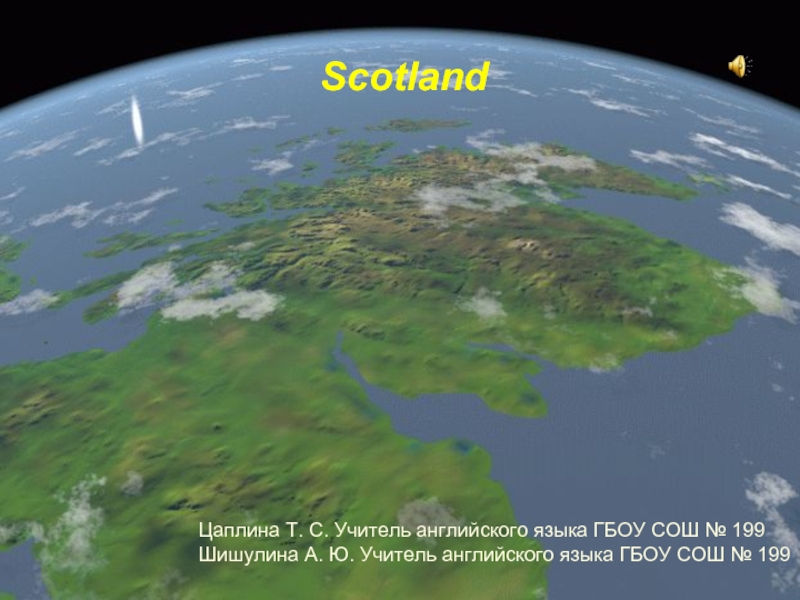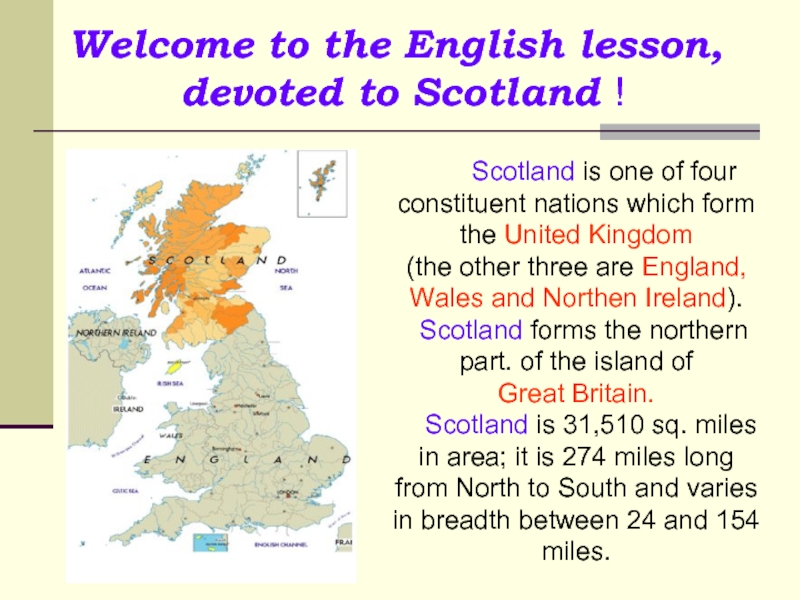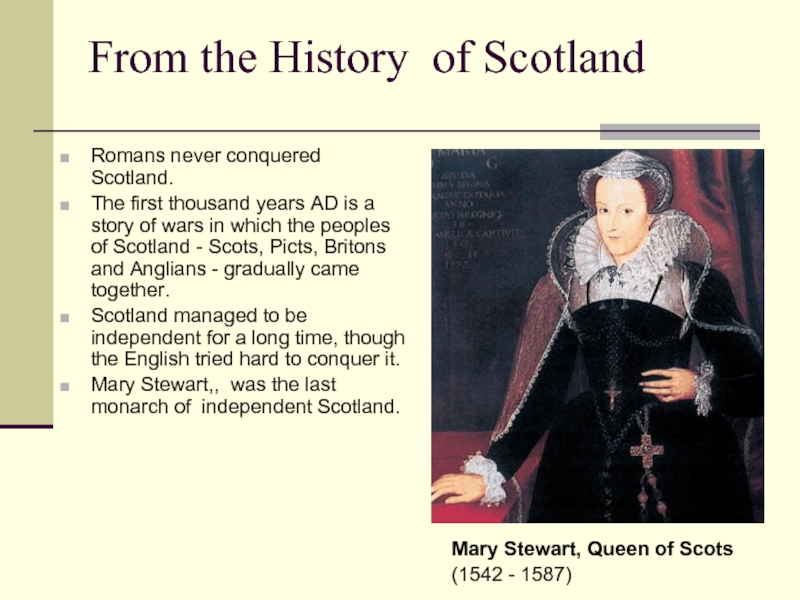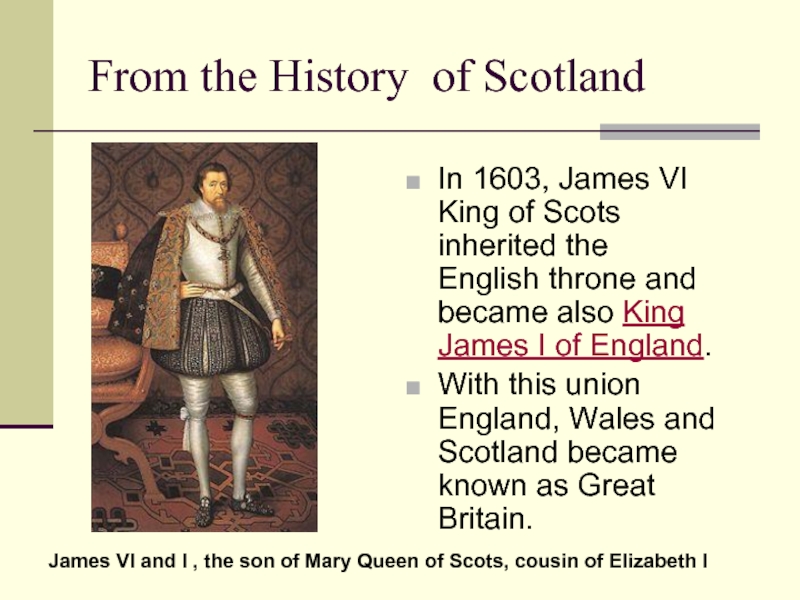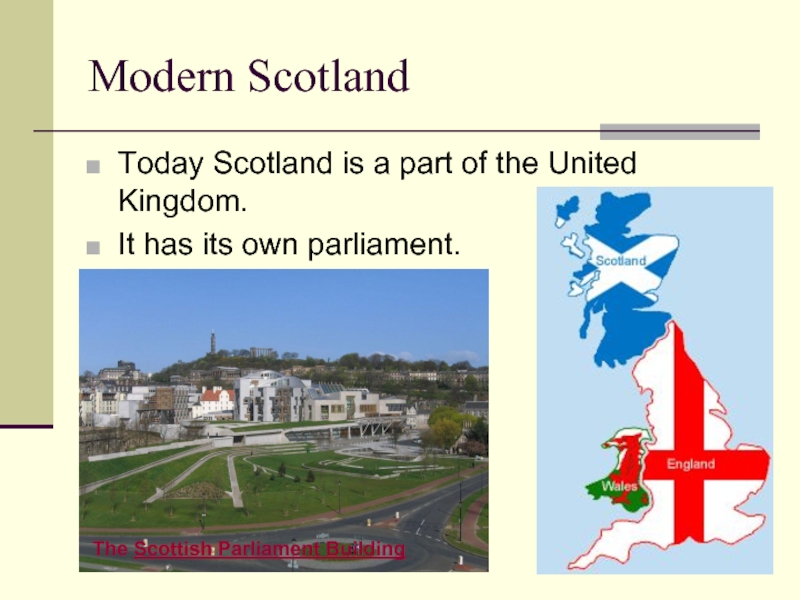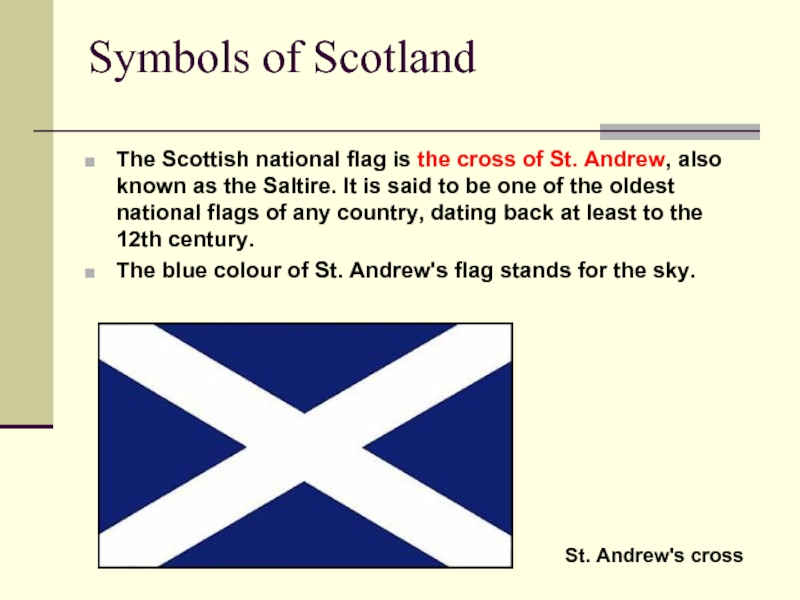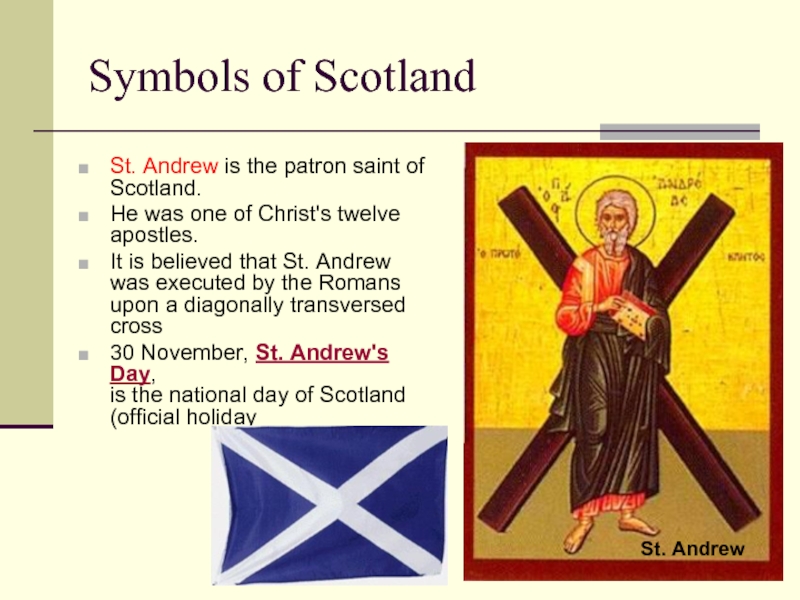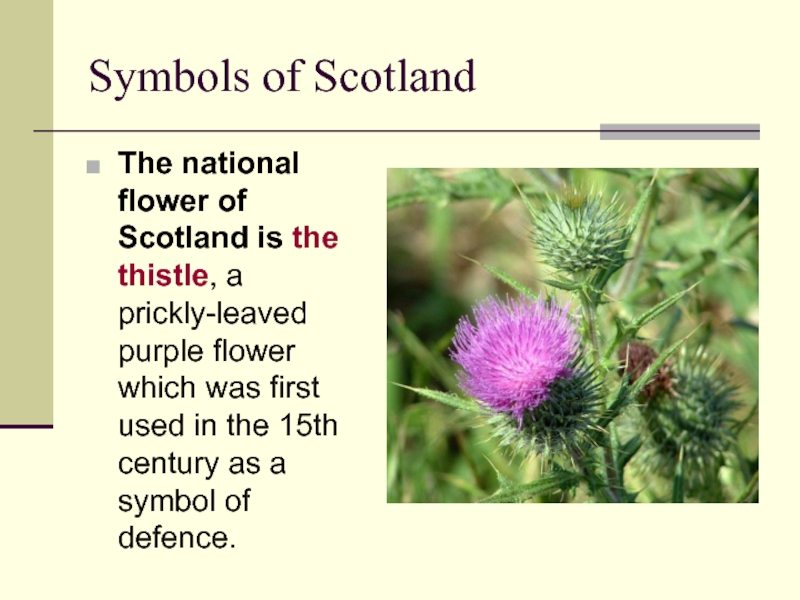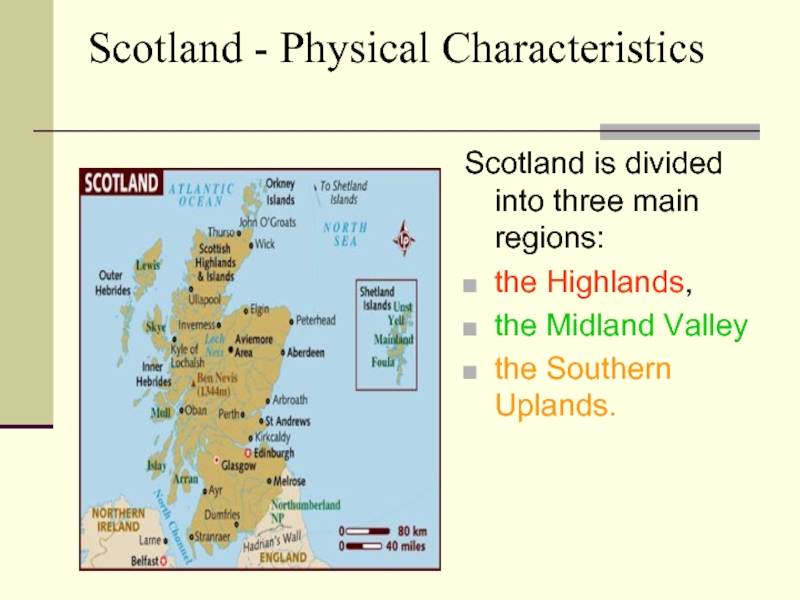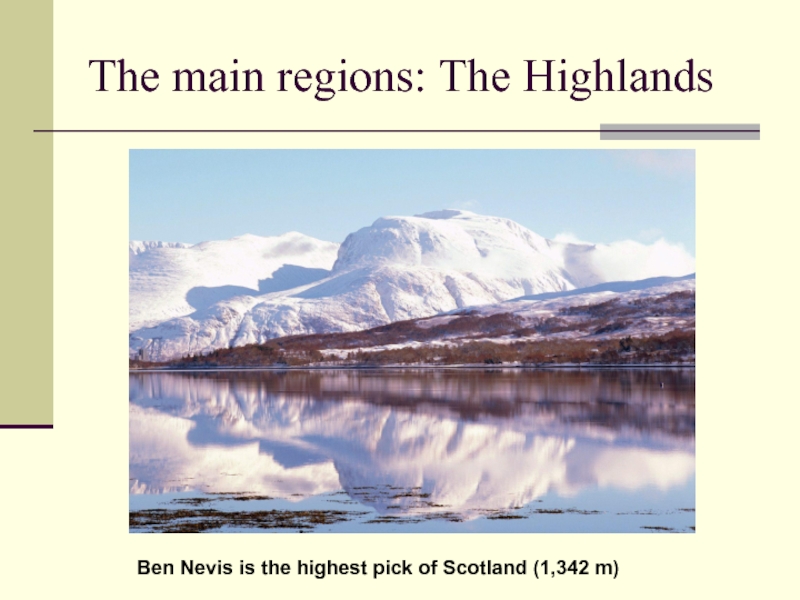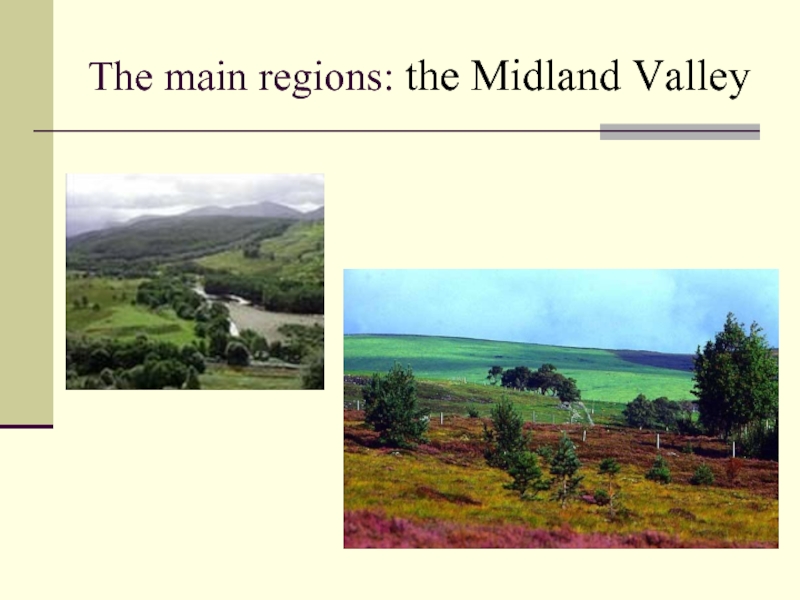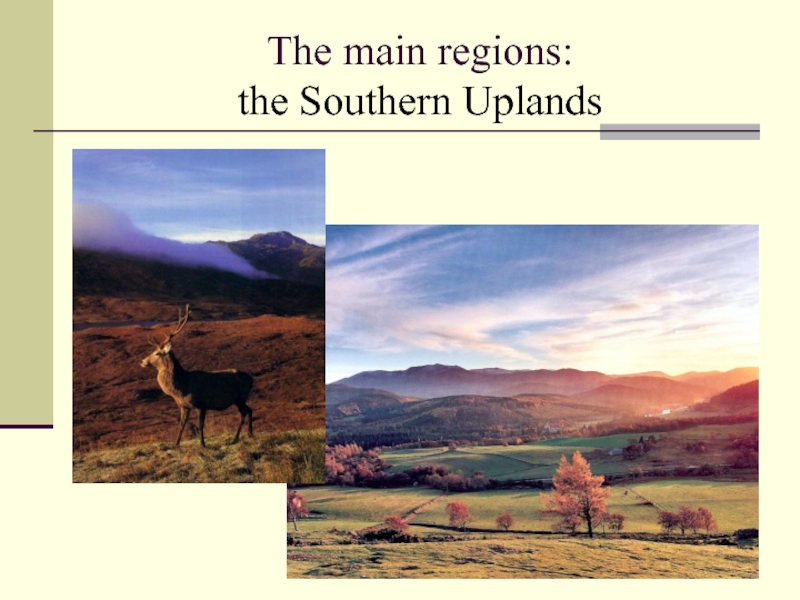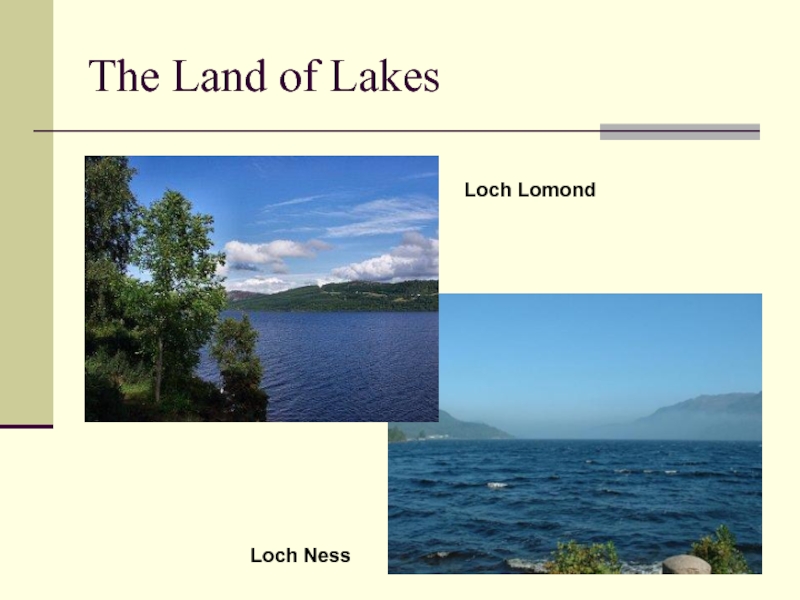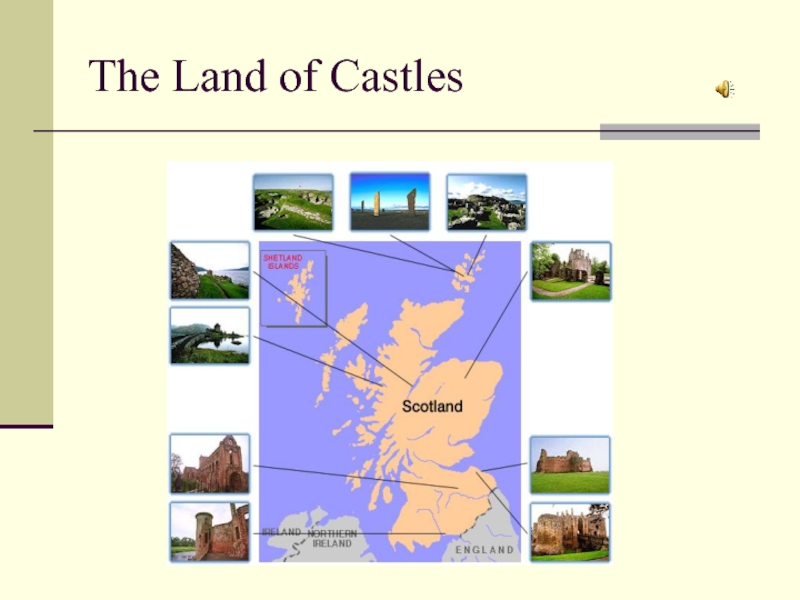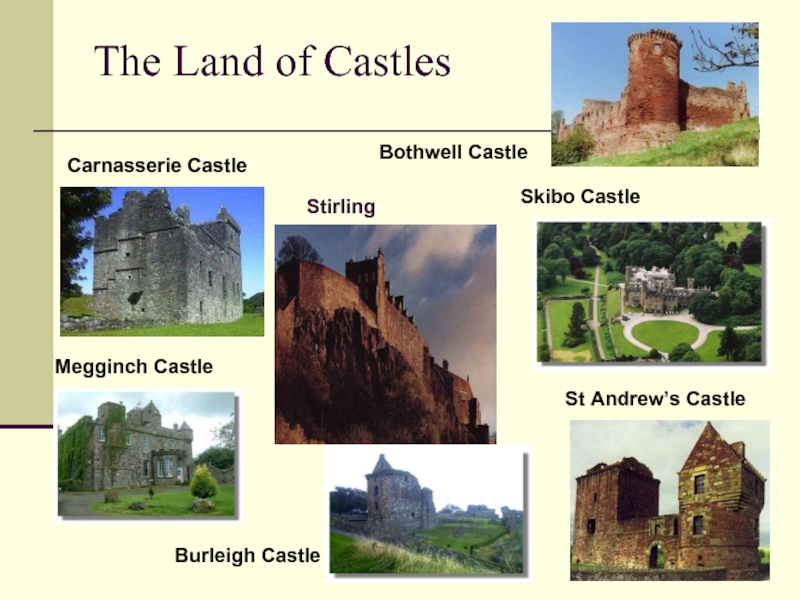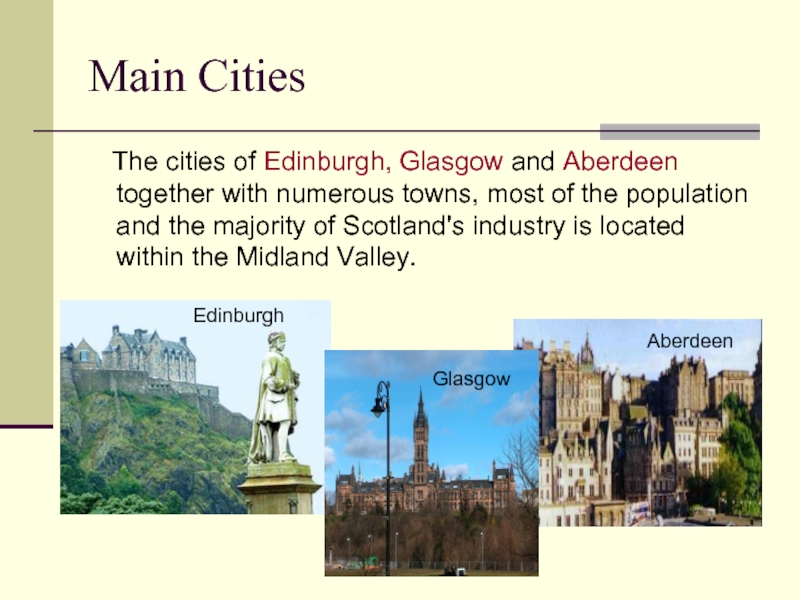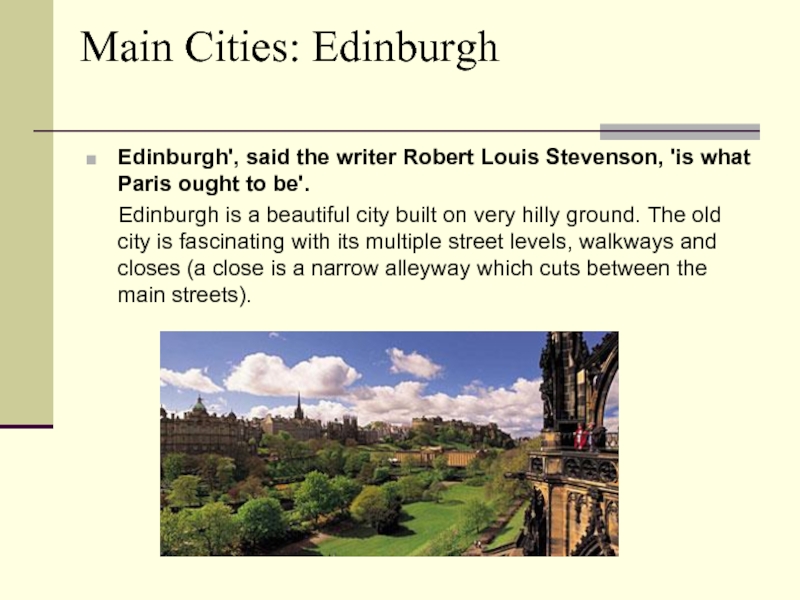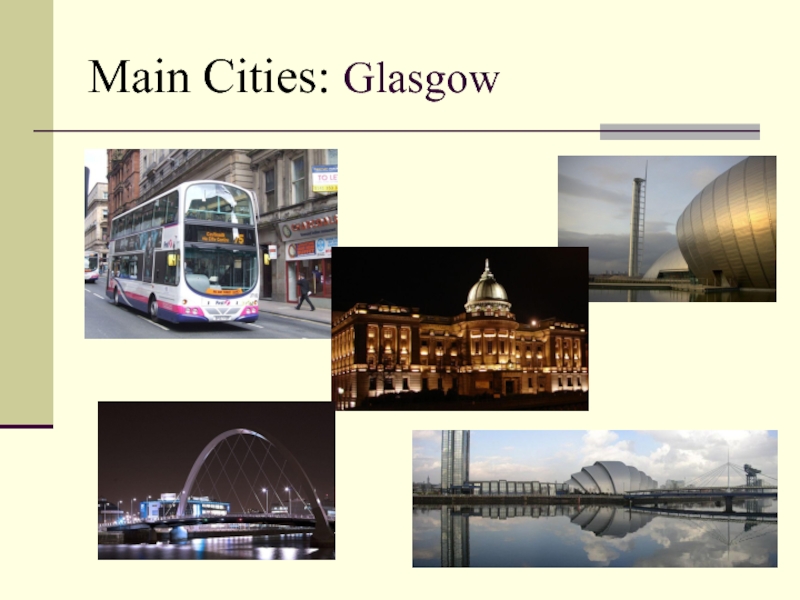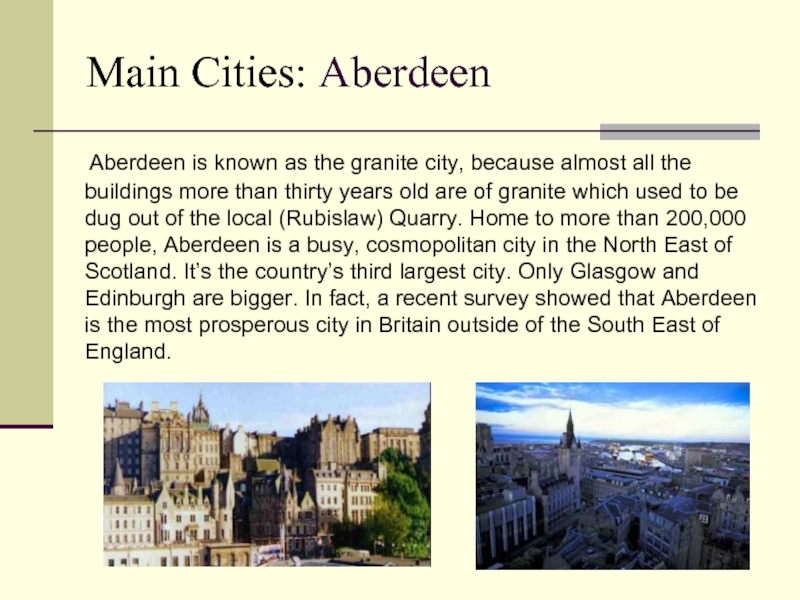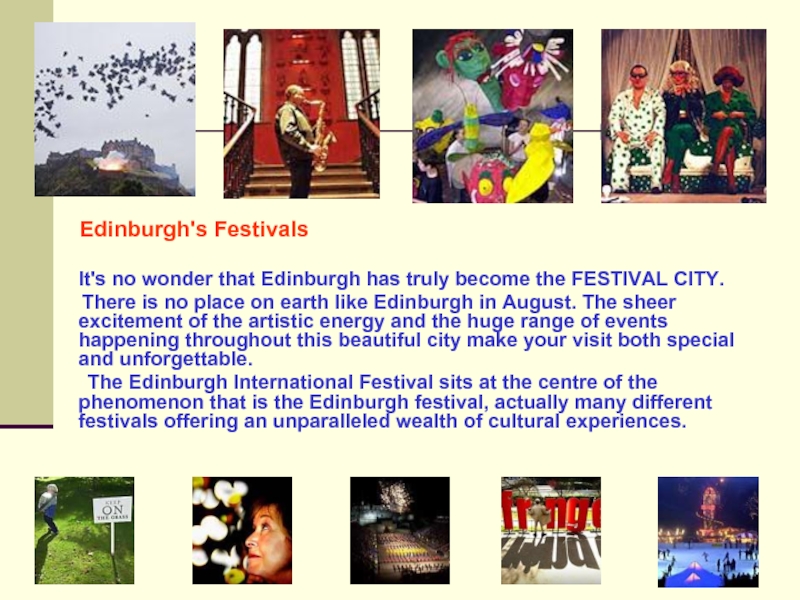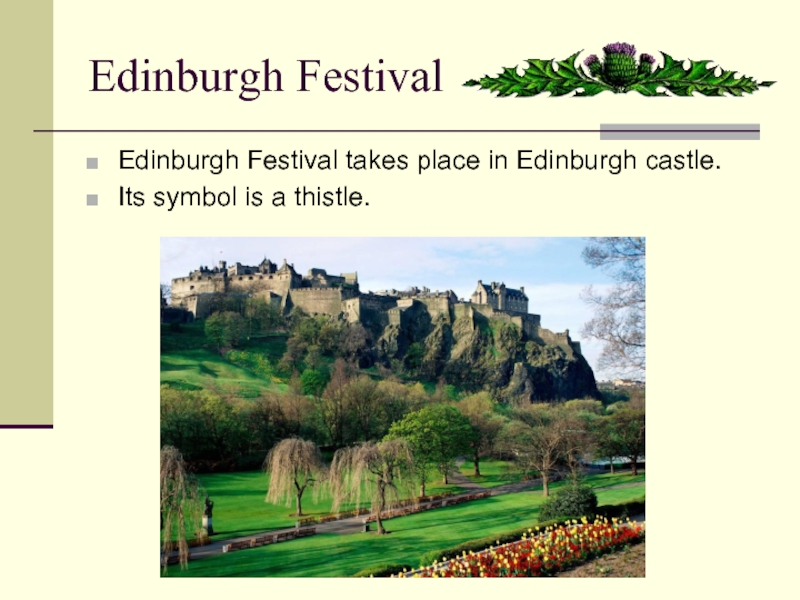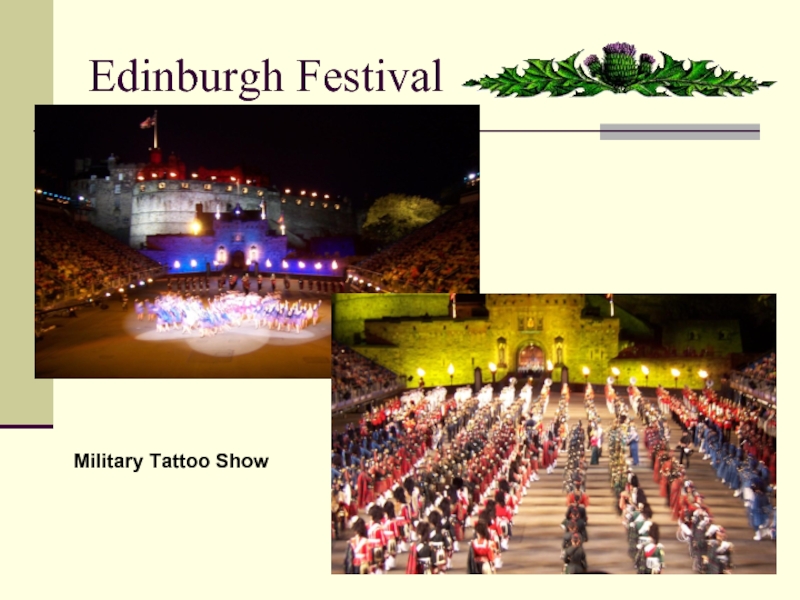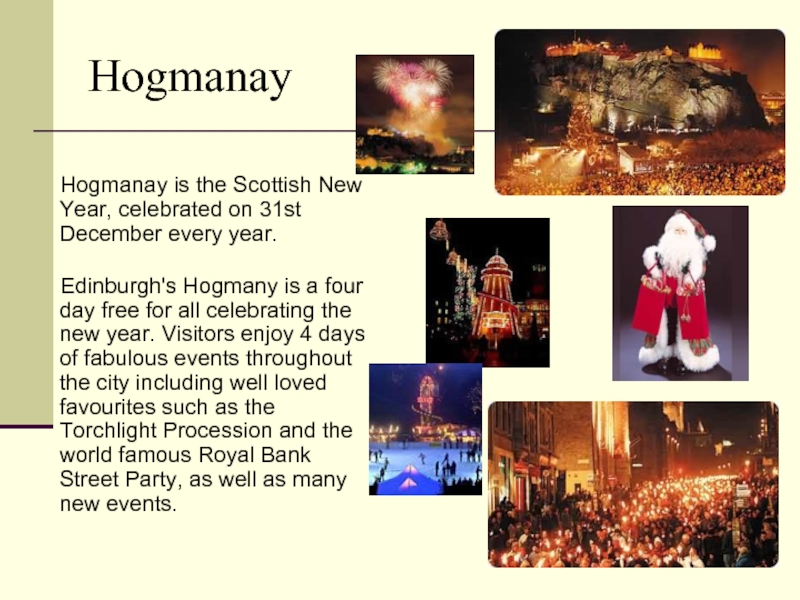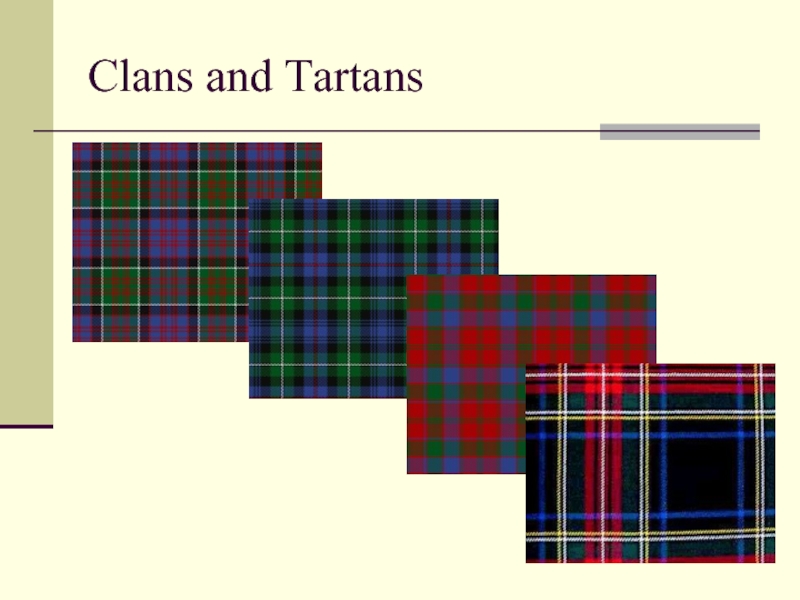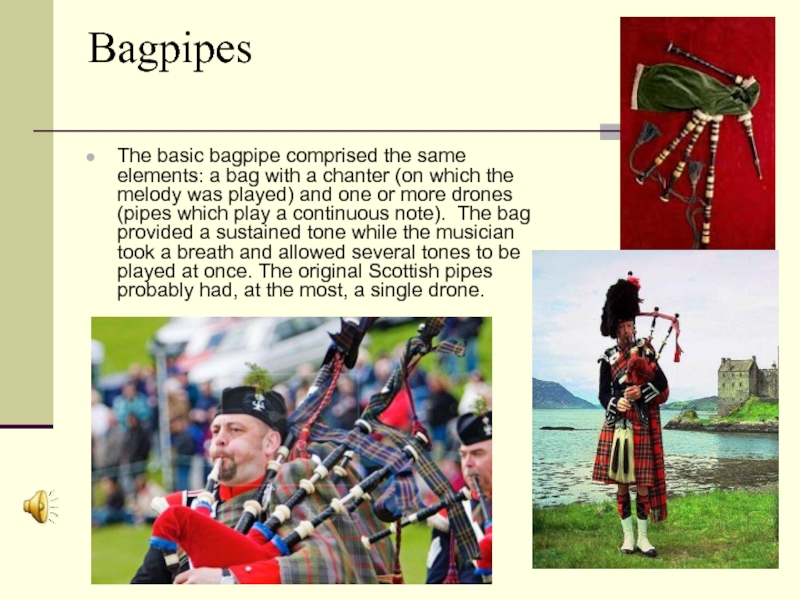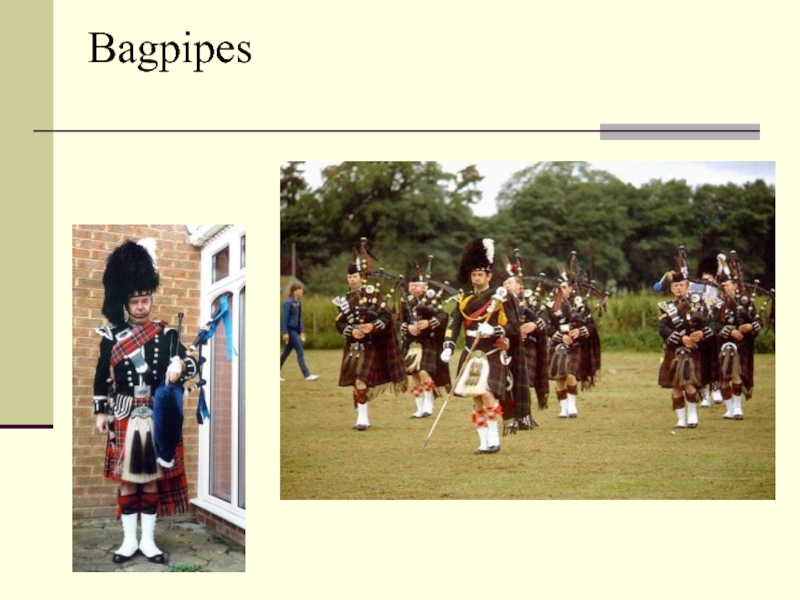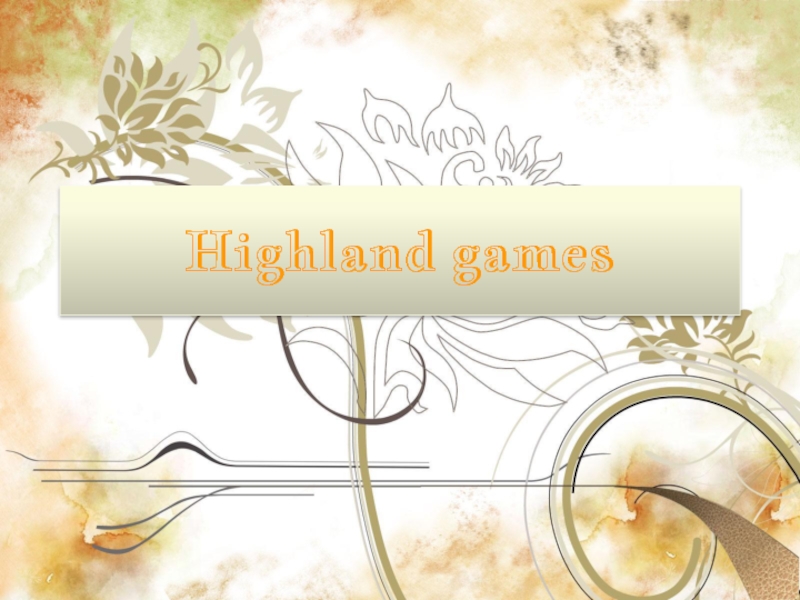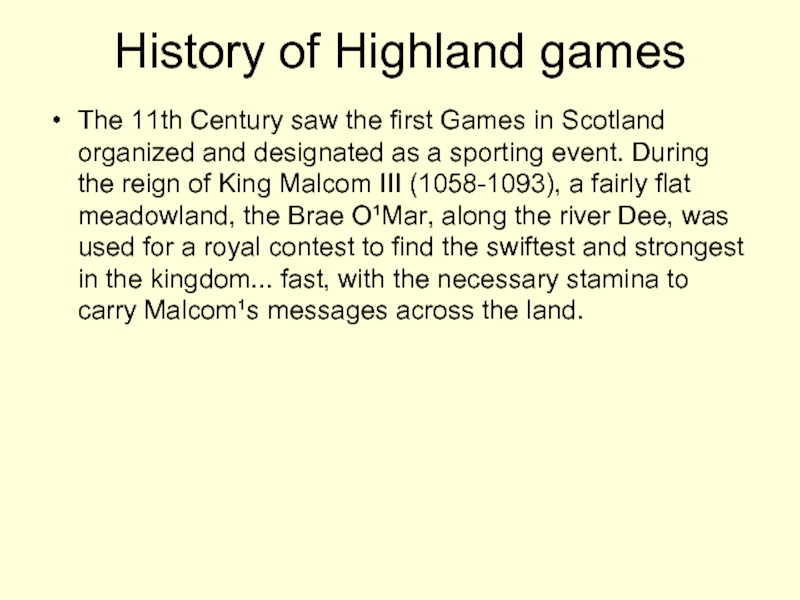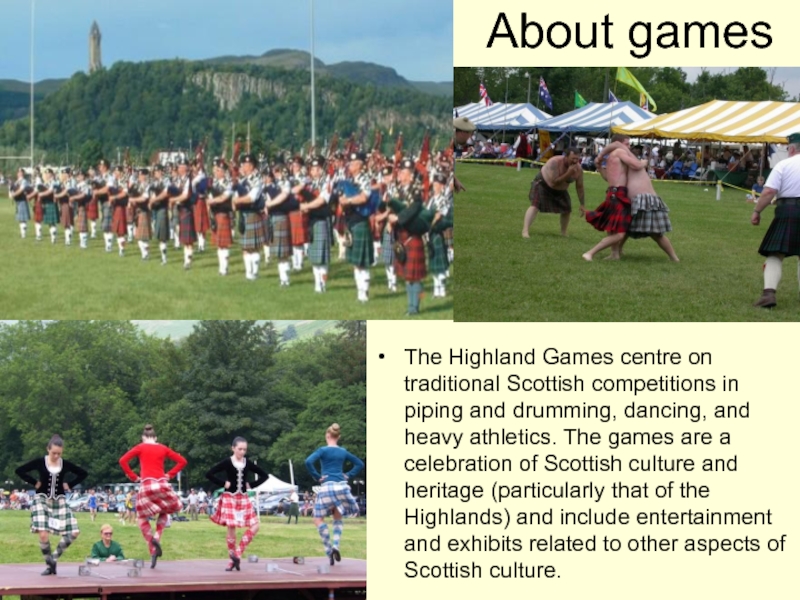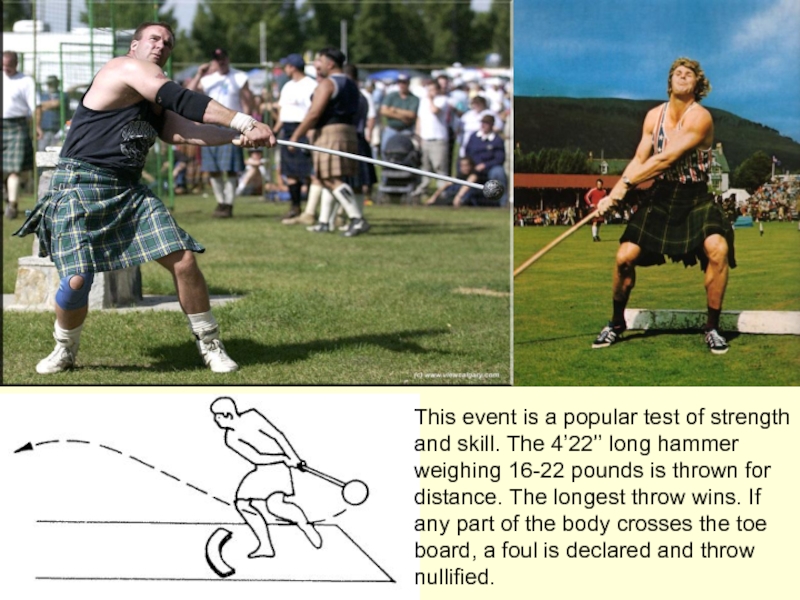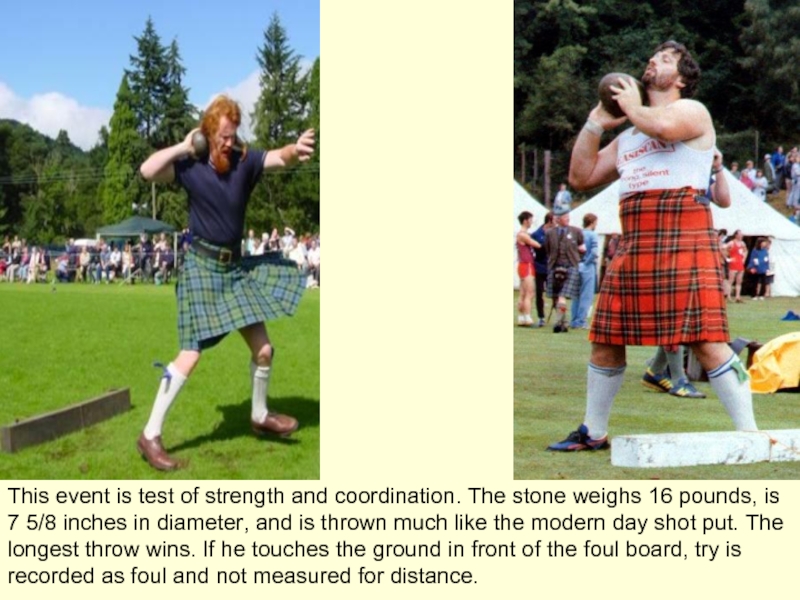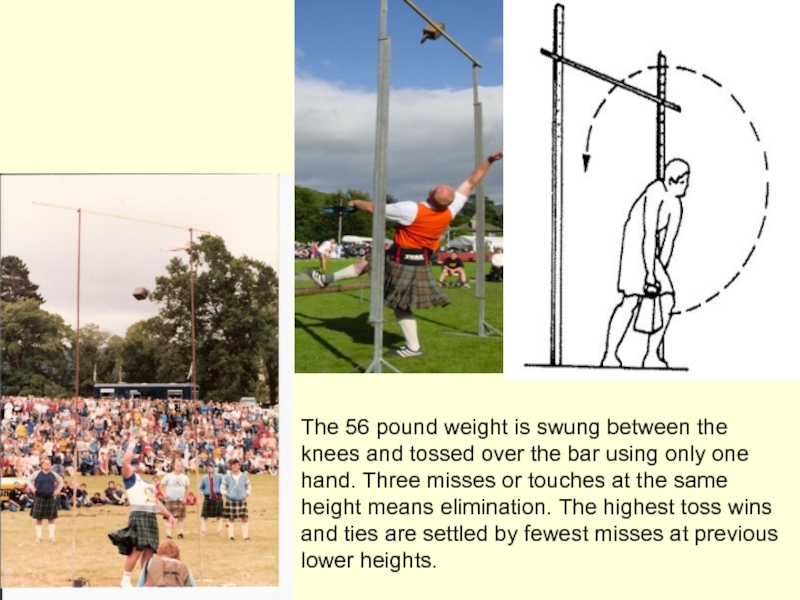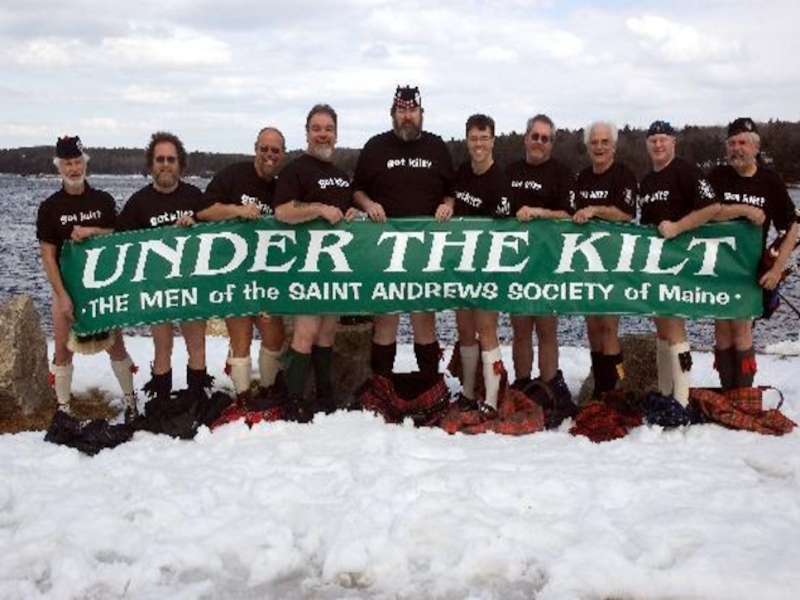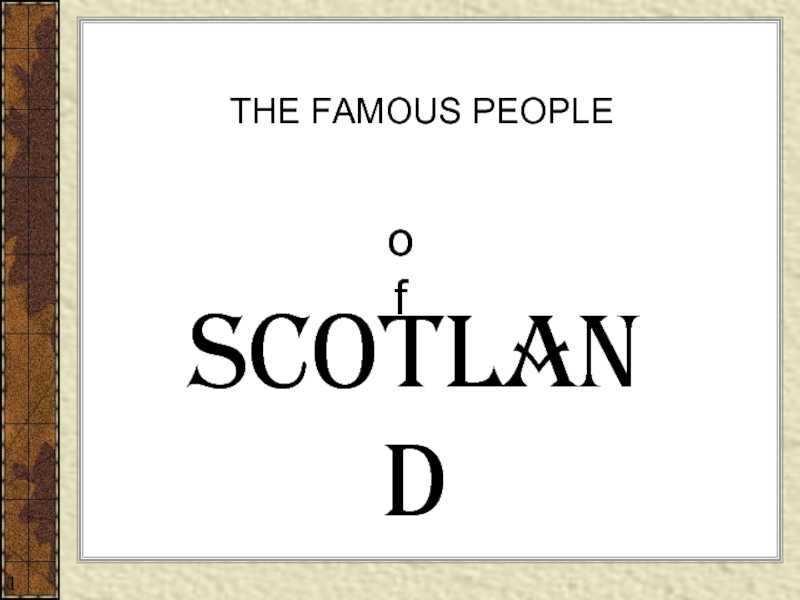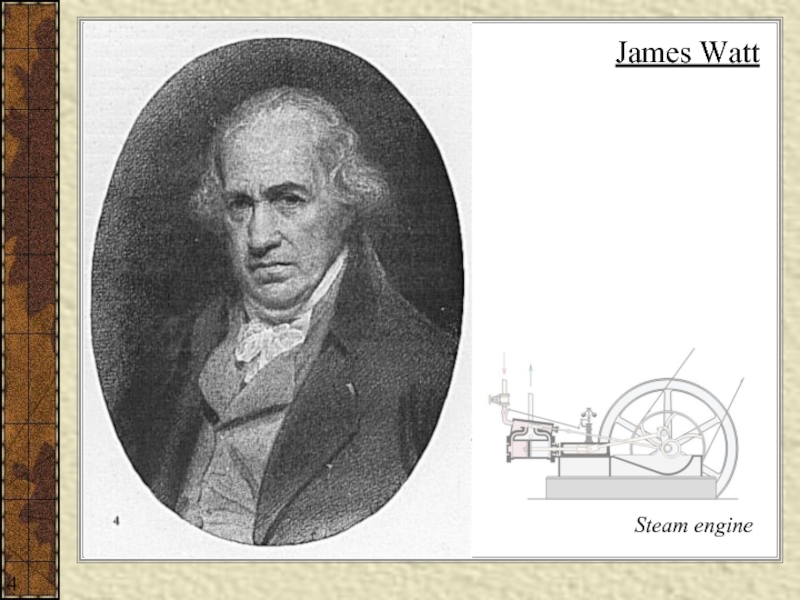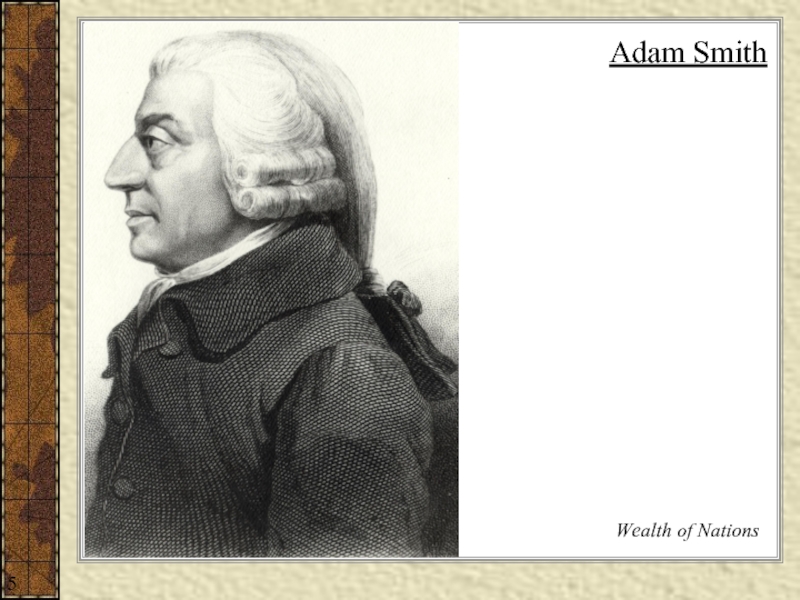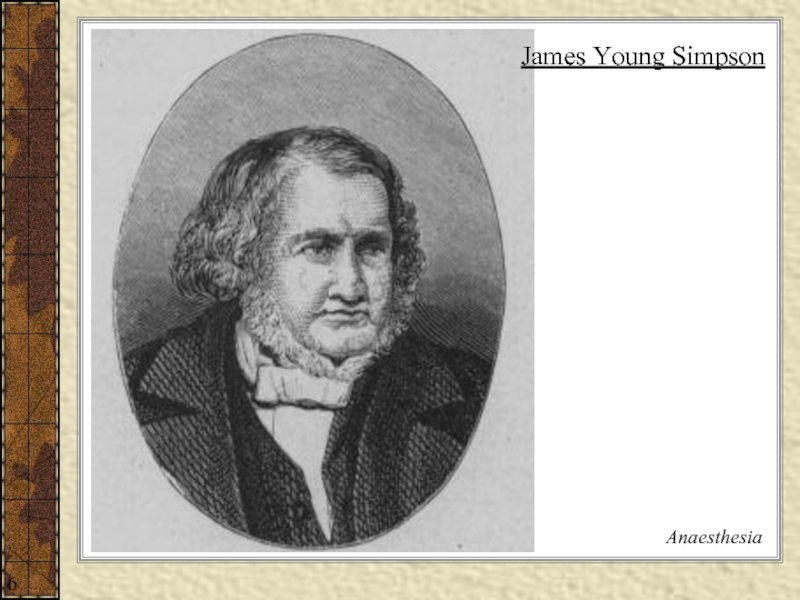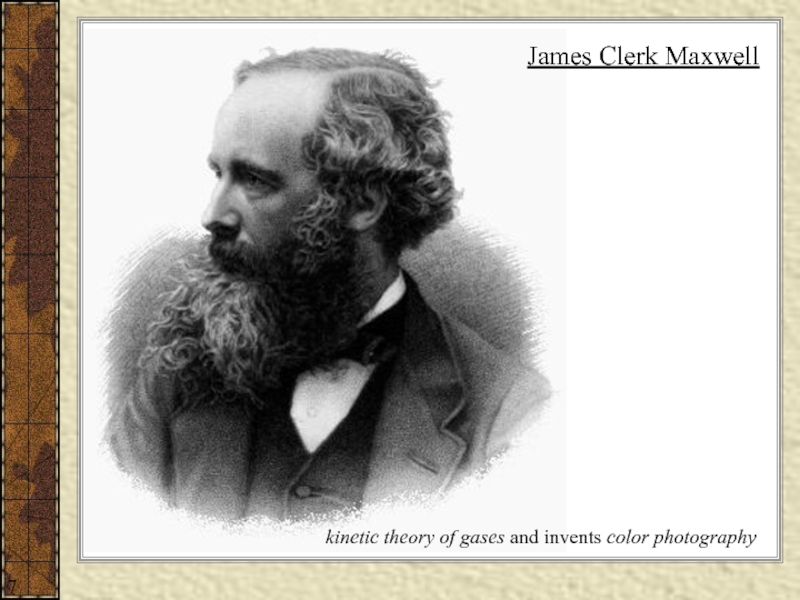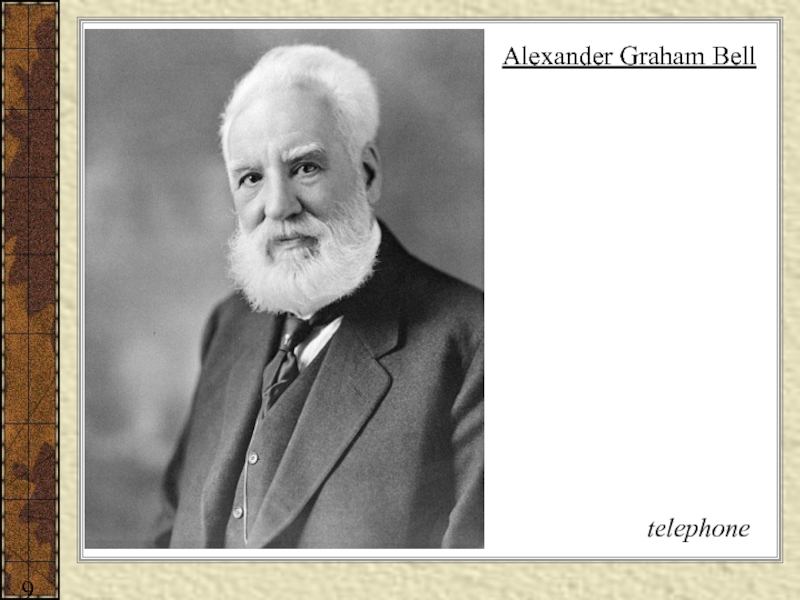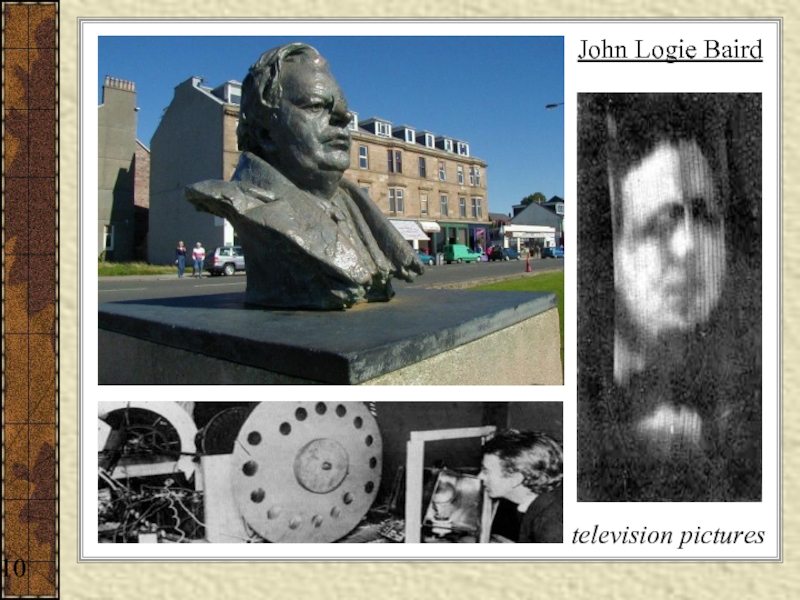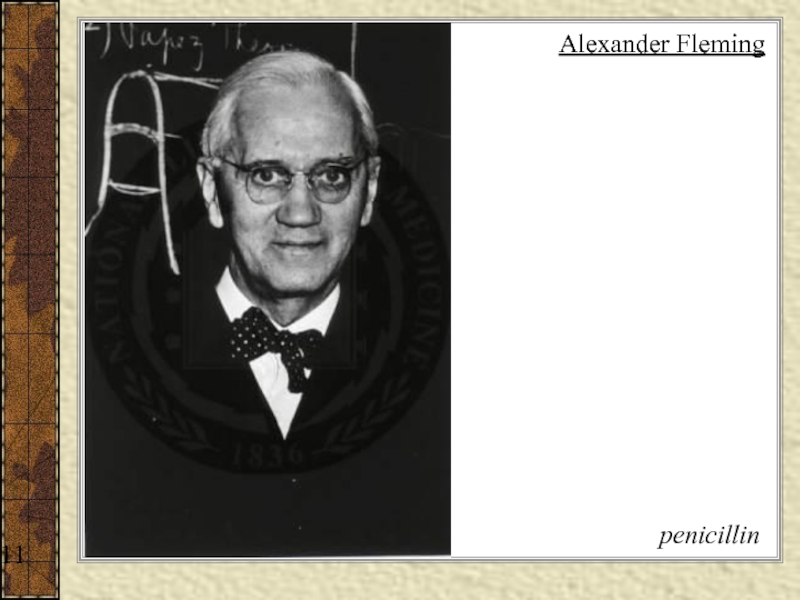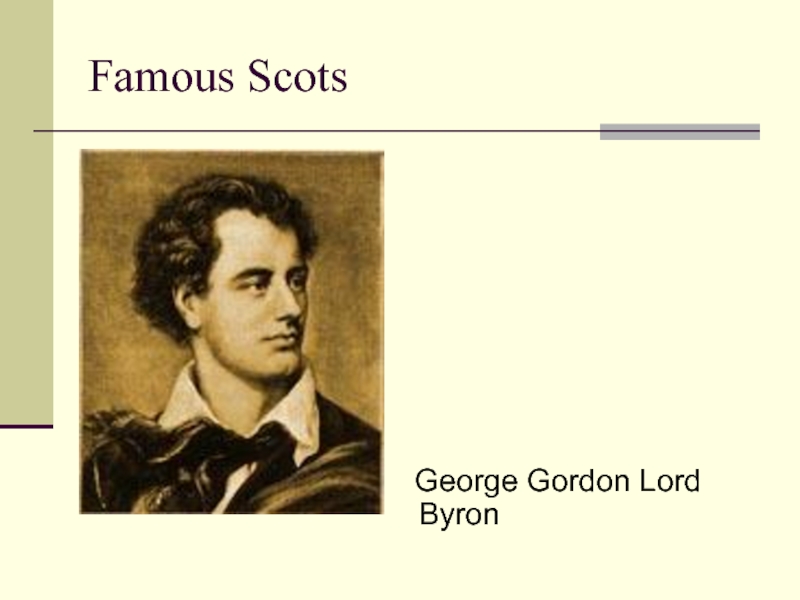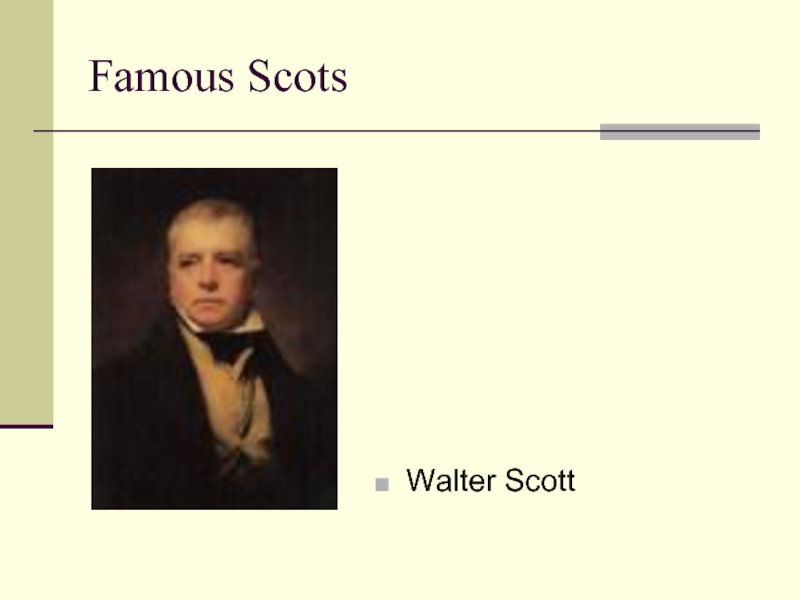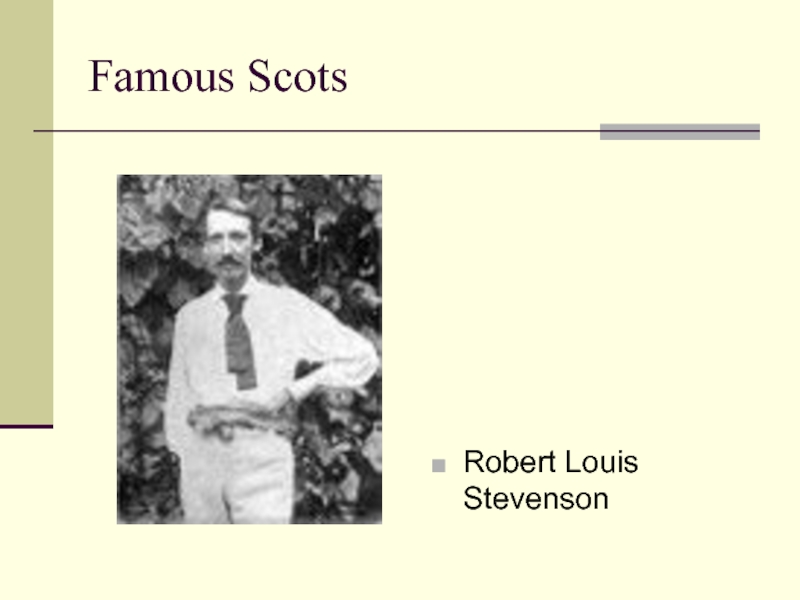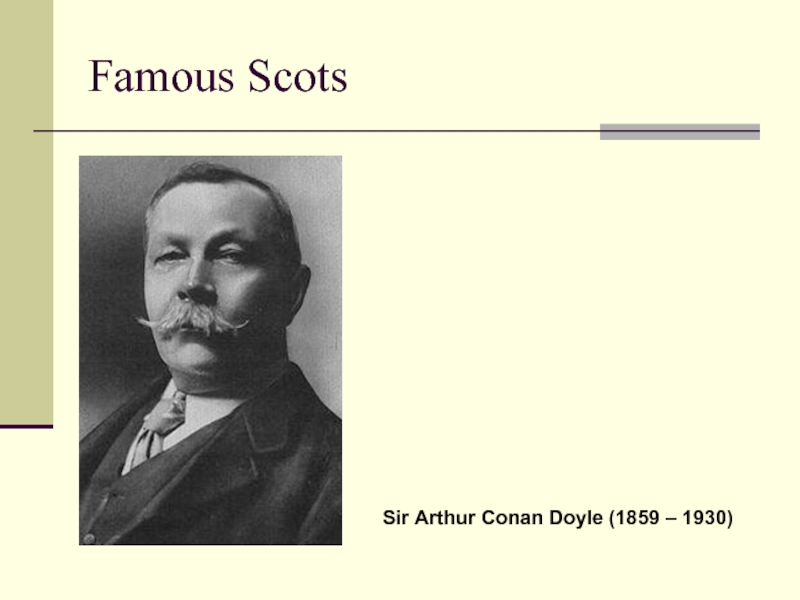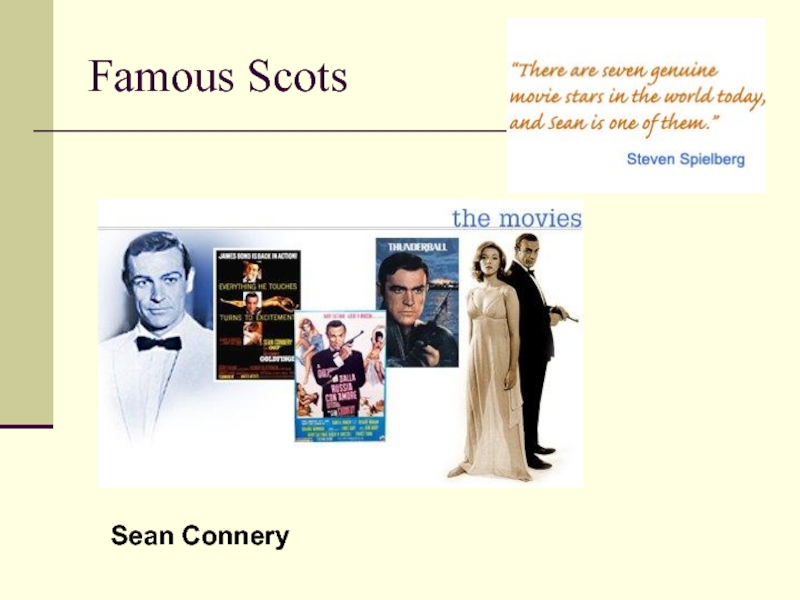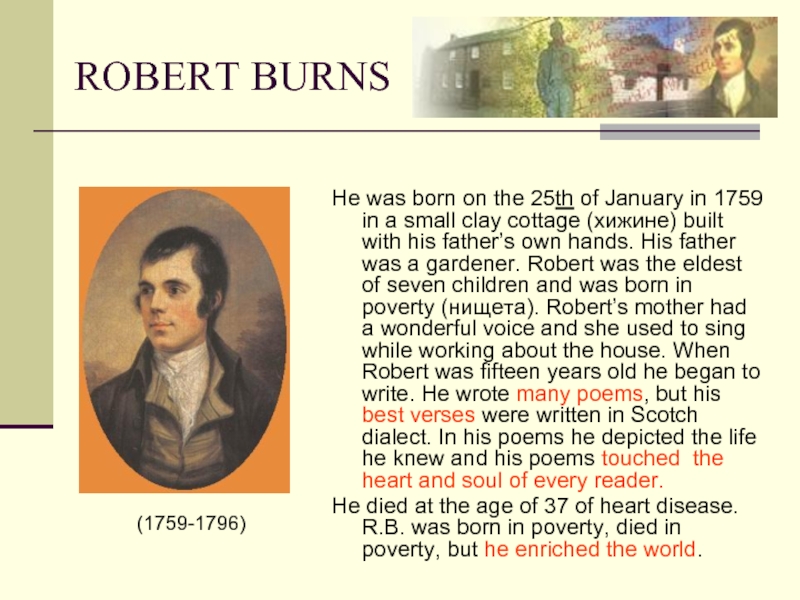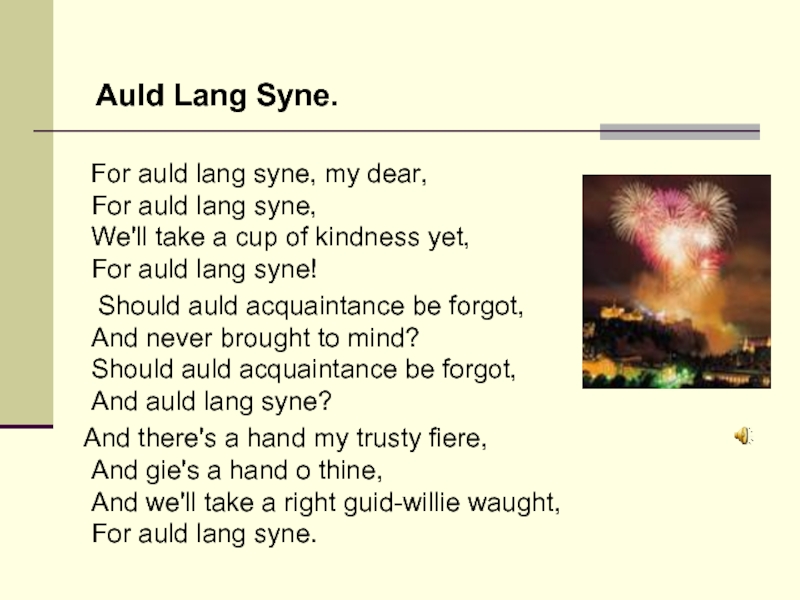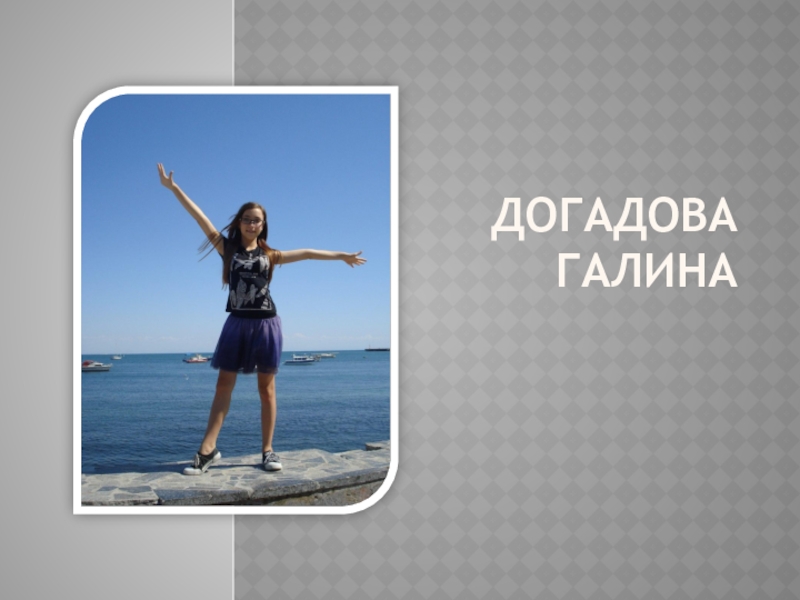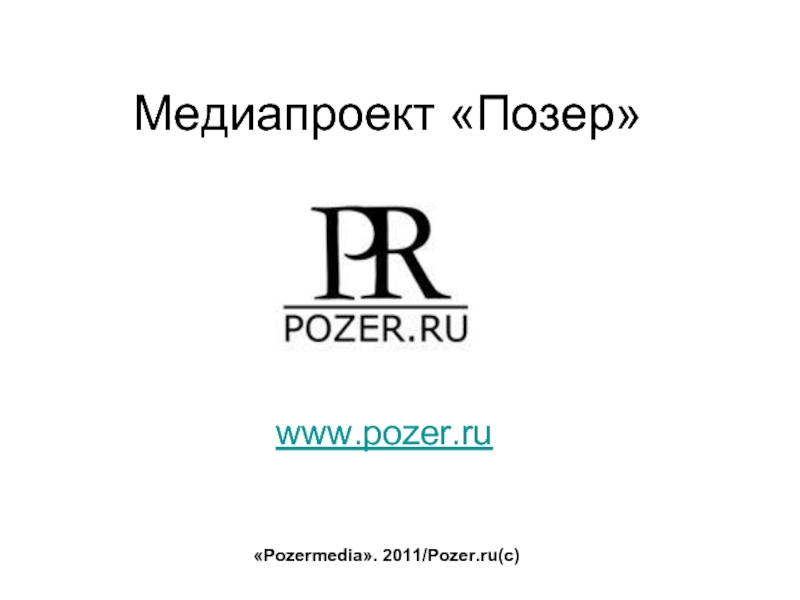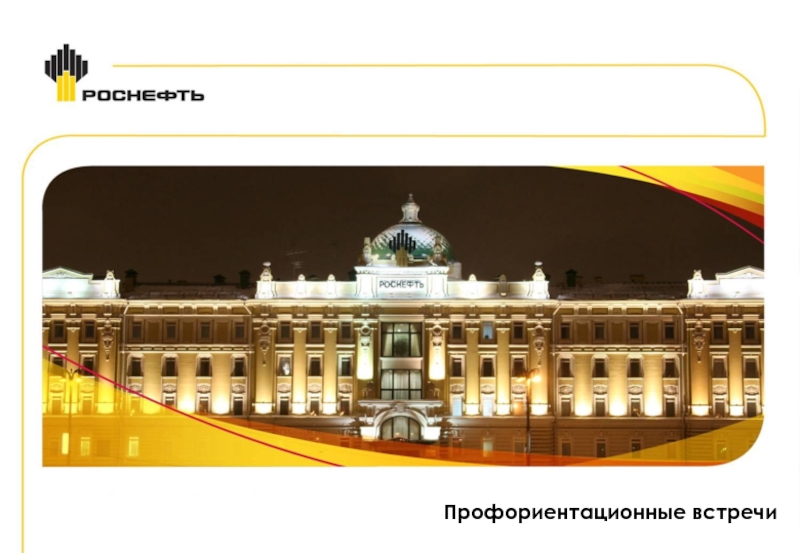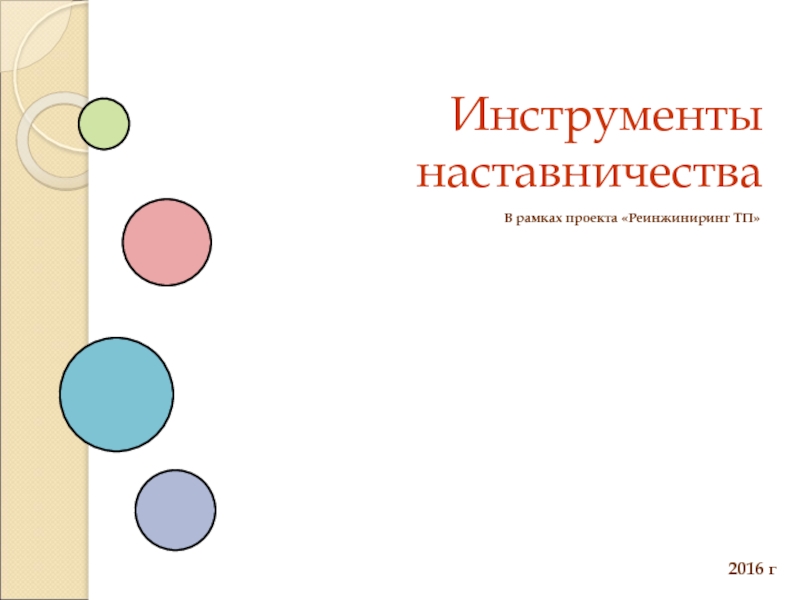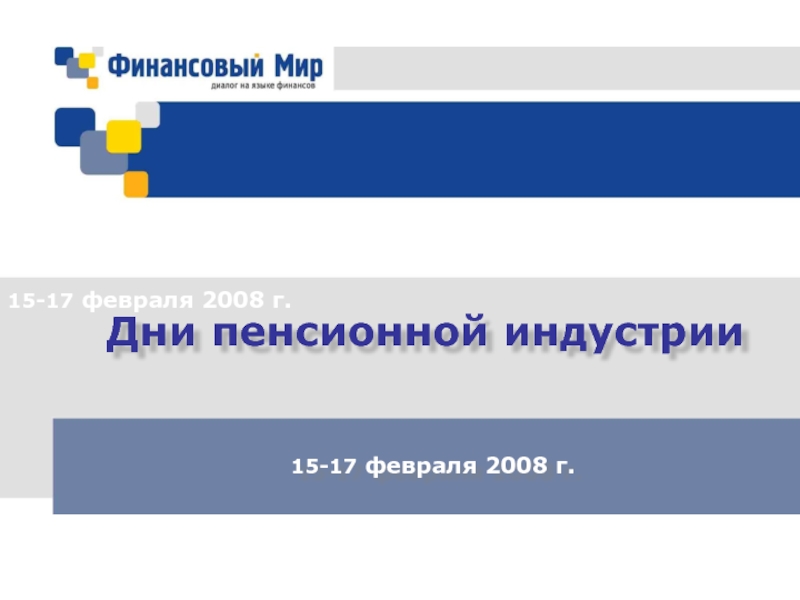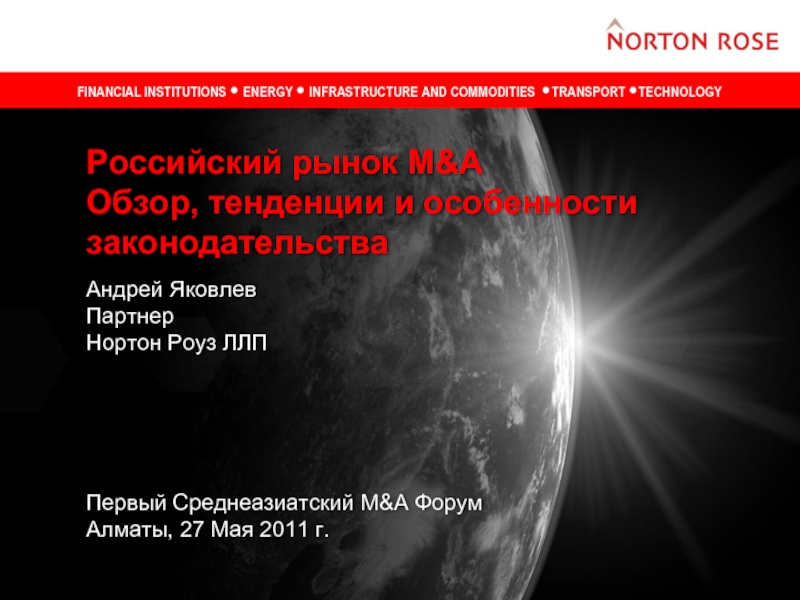- Главная
- Разное
- Дизайн
- Бизнес и предпринимательство
- Аналитика
- Образование
- Развлечения
- Красота и здоровье
- Финансы
- Государство
- Путешествия
- Спорт
- Недвижимость
- Армия
- Графика
- Культурология
- Еда и кулинария
- Лингвистика
- Английский язык
- Астрономия
- Алгебра
- Биология
- География
- Детские презентации
- Информатика
- История
- Литература
- Маркетинг
- Математика
- Медицина
- Менеджмент
- Музыка
- МХК
- Немецкий язык
- ОБЖ
- Обществознание
- Окружающий мир
- Педагогика
- Русский язык
- Технология
- Физика
- Философия
- Химия
- Шаблоны, картинки для презентаций
- Экология
- Экономика
- Юриспруденция
Scotland презентация
Содержание
- 1. Scotland
- 2. Welcome to the English lesson, devoted
- 3. From the History of Scotland Romans never
- 4. From the History of Scotland In 1603,
- 5. Modern Scotland Today Scotland is a part
- 6. Symbols of Scotland The Scottish national flag
- 7. Symbols of Scotland St. Andrew is the
- 8. Symbols of Scotland The Royal Scottish Flag.
- 9. Symbols of Scotland The national flower of
- 10. Scotland - Physical Characteristics Scotland is
- 11. The main regions: The Highlands The Highlands:
- 12. The main regions: The Highlands
- 13. The main regions: The Highlands Ben Nevis is the highest pick of Scotland (1,342 m)
- 14. The main regions: the Midland Valley
- 15. The main regions: the Southern Uplands
- 16. The Land of Lakes Loch Ness Loch Lomond
- 17. The Land of Castles
- 18. Stirling Bothwell Castle Carnasserie Castle
- 19. The cities of Edinburgh, Glasgow
- 20. Main Cities: Edinburgh Edinburgh', said the
- 21. Main Cities: Glasgow
- 22. Main Cities: Aberdeen
- 23. Edinburgh's Festivals
- 24. Edinburgh Festival Edinburgh Festival takes place in Edinburgh castle. Its symbol is a thistle.
- 25. Edinburgh Festival Military Tattoo Show
- 26. Hogmanay Hogmanay is the
- 27. Clans and Tartans
- 28. Kilts
- 29. Bagpipes The basic bagpipe comprised
- 30. Bagpipes
- 31. Highland games
- 32. History of Highland games The 11th Century
- 33. About games The Highland Games centre on
- 34. This event, like so many athletic events,
- 35. This event is a popular test of
- 36. This event is test of strength and
- 37. The 14-25 pound sheaf of hay, wrapped
- 38. The 28 and 56 pound weights are
- 39. The 56 pound weight is swung between
- 41. Scotland THE FAMOUS PEOPLE of 1
- 42. Scottish inspiration PEOPLE: 1740 – David Hume
- 43. 3 David Hume A Treatise of Human Nature
- 44. 4 James Watt Steam engine
- 45. 5 Adam Smith Wealth of Nations
- 46. 6 James Young Simpson Anaesthesia
- 47. 7 James Clerk Maxwell kinetic theory of gases and invents color photography
- 48. 8 Josef Lister antiseptics
- 49. Alexander Graham Bell telephone 9
- 50. John Logie Baird television pictures 10
- 51. Alexander Fleming penicillin 11
- 52. Famous Scots George Gordon Lord Byron
- 53. Famous Scots Walter Scott
- 54. Famous Scots Robert Louis Stevenson
- 55. Famous Scots Sir Arthur Conan Doyle (1859 – 1930)
- 56. Famous Scots Sean Connery
- 57. ROBERT BURNS He was
- 58. Auld Lang Syne.
Слайд 1Scotland
Scotland
Цаплина Т. С. Учитель английского языка ГБОУ СОШ № 199
Шишулина А.
Слайд 2Welcome to the English lesson,
devoted to Scotland !
(the other three are England, Wales and Northen Ireland).
Scotland forms the northern part. of the island of
Great Britain.
Scotland is 31,510 sq. miles in area; it is 274 miles long from North to South and varies in breadth between 24 and 154 miles.
Слайд 3From the History of Scotland
Romans never conquered Scotland.
The first thousand years
Scotland managed to be independent for a long time, though the English tried hard to conquer it.
Mary Stewart,, was the last monarch of independent Scotland.
Mary Stewart, Queen of Scots
(1542 - 1587)
Слайд 4From the History of Scotland
In 1603, James VI King of Scots
With this union England, Wales and Scotland became known as Great Britain.
James VI and I , the son of Mary Queen of Scots, cousin of Elizabeth I
Слайд 5Modern Scotland
Today Scotland is a part of the United Kingdom.
It has
The Scottish Parliament Building
Слайд 6Symbols of Scotland
The Scottish national flag is the cross of St.
The blue colour of St. Andrew's flag stands for the sky.
St. Andrew's cross
Слайд 7Symbols of Scotland
St. Andrew is the patron saint of Scotland.
He was
It is believed that St. Andrew was executed by the Romans upon a diagonally transversed cross
30 November, St. Andrew's Day, is the national day of Scotland (official holiday
St. Andrew
Слайд 9Symbols of Scotland
The national flower of Scotland is the thistle, a
Слайд 10Scotland - Physical Characteristics
Scotland is divided into three main regions:
the Highlands,
the Midland Valley
the Southern Uplands.
Слайд 11The main regions: The Highlands
The Highlands: This legendary region of Scotland
Слайд 18Stirling
Bothwell Castle
Carnasserie Castle
Burleigh Castle
Megginch Castle
Skibo Castle
St
The Land of Castles
Слайд 19 The cities of Edinburgh, Glasgow and Aberdeen together with
Edinburgh
Aberdeen
Glasgow
Main Cities
Слайд 20Main Cities: Edinburgh
Edinburgh', said the writer Robert Louis Stevenson, 'is what
Edinburgh is a beautiful city built on very hilly ground. The old city is fascinating with its multiple street levels, walkways and closes (a close is a narrow alleyway which cuts between the main streets).
Слайд 22Main Cities: Aberdeen
Aberdeen is known as the granite
Слайд 23 Edinburgh's Festivals
It's no wonder that Edinburgh has
There is no place on earth like Edinburgh in August. The sheer excitement of the artistic energy and the huge range of events happening throughout this beautiful city make your visit both special and unforgettable.
The Edinburgh International Festival sits at the centre of the phenomenon that is the Edinburgh festival, actually many different festivals offering an unparalleled wealth of cultural experiences.
Слайд 24Edinburgh Festival
Edinburgh Festival takes place in Edinburgh castle.
Its symbol is a
Слайд 26Hogmanay
Hogmanay is the Scottish New Year, celebrated on
Edinburgh's Hogmany is a four day free for all celebrating the new year. Visitors enjoy 4 days of fabulous events throughout the city including well loved favourites such as the Torchlight Procession and the world famous Royal Bank Street Party, as well as many new events.
Слайд 29Bagpipes
The basic bagpipe comprised the same elements: a bag with
Слайд 32History of Highland games
The 11th Century saw the first Games in
Слайд 33About games
The Highland Games centre on traditional Scottish competitions in piping
Слайд 34This event, like so many athletic events, may well have begun
Слайд 35This event is a popular test of strength and skill. The
Слайд 36This event is test of strength and coordination. The stone weighs
Слайд 37The 14-25 pound sheaf of hay, wrapped in burlap, is tossed
Слайд 38The 28 and 56 pound weights are thrown for distance. Three
Слайд 39The 56 pound weight is swung between the knees and tossed
Слайд 42Scottish inspiration PEOPLE:
1740 – David Hume publishes A Treatise of
1774 – James Watt patents the Steam engine
1776 – Adam Smith writes Wealth of Nations
1847 – James Young Simpson pioneers Anaesthesia
1860s– James Clerk Maxwell develops the kinetic theory of gases and invents color photography
1860 – Josef Lister pioneers antiseptics
1876 – Alexander Graham Bell invents the telephone
1926 – John Logie Baird transmits the first television pictures
1928 – Alexander Fleming discovers penicillin
2
Слайд 57
ROBERT BURNS
He was born on the 25th of January in 1759
He died at the age of 37 of heart disease. R.B. was born in poverty, died in poverty, but he enriched the world.
(1759-1796)
Слайд 58
Auld Lang Syne.
For auld lang syne,
Should auld acquaintance be forgot, And never brought to mind? Should auld acquaintance be forgot, And auld lang syne?
And there's a hand my trusty fiere, And gie's a hand o thine, And we'll take a right guid-willie waught, For auld lang syne.
